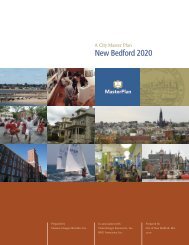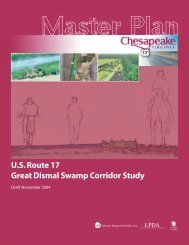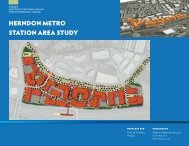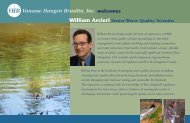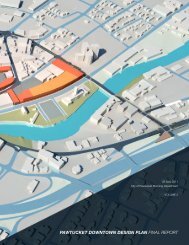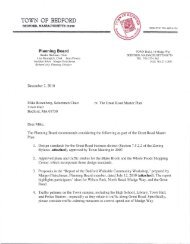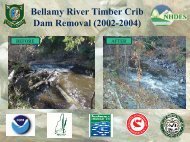Final Report - VHB.com
Final Report - VHB.com
Final Report - VHB.com
You also want an ePaper? Increase the reach of your titles
YUMPU automatically turns print PDFs into web optimized ePapers that Google loves.
Throughout this Feasibility Study, the terms strategy and option are used to describe<br />
different alternatives for achieving the improved access to the redeveloped NASB.<br />
The term strategy refers to larger transportation and land-use needs used<br />
individually or in <strong>com</strong>bination to achieve better access to the NASB. Different ways<br />
of achieving those strategies are considered options. Potential options for a defined<br />
strategy may include actions such as the widening of an existing roadway, addition<br />
of turn lanes, improved traffic-signal timing, and implementation of Transportation<br />
Demand Management (TDM) actions.<br />
For this Study, five specific strategies were identified for evaluation. These five<br />
strategies were provided to the MaineDOT by the Governor’s Advisory Council and<br />
formulated through the previous NASB Reuse Master Plan study efforts conducted by<br />
the MRRA. Focusing the evaluation effort on these five strategies ensures that the<br />
evaluation is conducted at a sufficient level of detail in order for decision makers to<br />
advance some of the preferred options to the permitting, design, and implementation<br />
phases. The five strategies or needs are as follows:<br />
Provide direct access to US Route 1 from the NASB.<br />
Improve mobility along State Route 196 (Coastal Connector) from I-295 (Exit 31)<br />
to US Route 1, including the State Route 196/US Route 201 intersection and US<br />
Route 201 north to Old Augusta Road.<br />
Improve mobility between I-295 (Exit 28) along Pleasant Street and Maine Street<br />
in Brunswick to State Route 123.<br />
Improve mobility along Mill Street from Pleasant Street in Brunswick to State<br />
Route 196.<br />
Extend the existing rail spur to the NASB.<br />
Whereas many transportation studies speak in terms of a single “Preferred Option,”<br />
this Feasibility Study seeks to identify a Preferred Option - perhaps more than one -<br />
for each strategy. It is important to understand that one strategy may be forwarded<br />
to construction independently of the others. The Preferred Options are prioritized for<br />
advancement based on the need to ac<strong>com</strong>modate base redevelopment.<br />
Each of the five strategies has a defined Study Area, which are shown in Figure 1-1.<br />
1.3 Purpose and Need<br />
The intent of the purpose and need outlined in this section is to describe and support<br />
the Feasibility Study. The purpose and need of a project establish a basis for the<br />
development of a range of reasonable options and assist with the identification,<br />
analysis, and eventual selection of a Preferred Option(s). The Purpose and Need<br />
Statement is used for <strong>com</strong>paring the effectiveness and impacts of the various Study<br />
options to the No Action Option.<br />
Introduction 13



